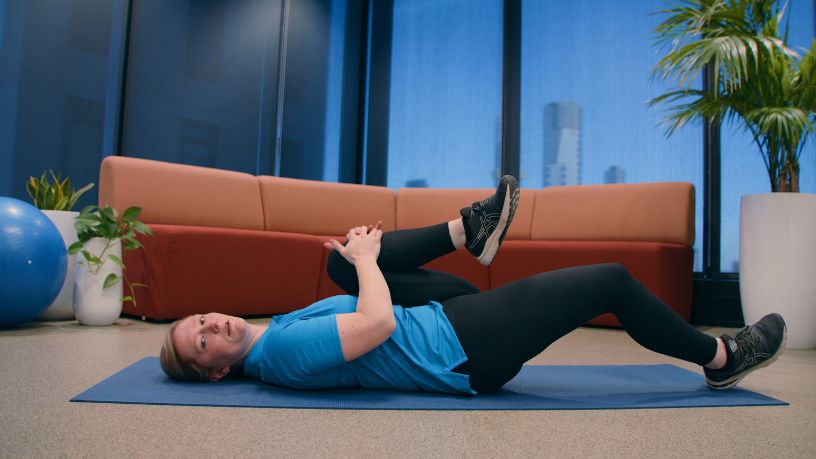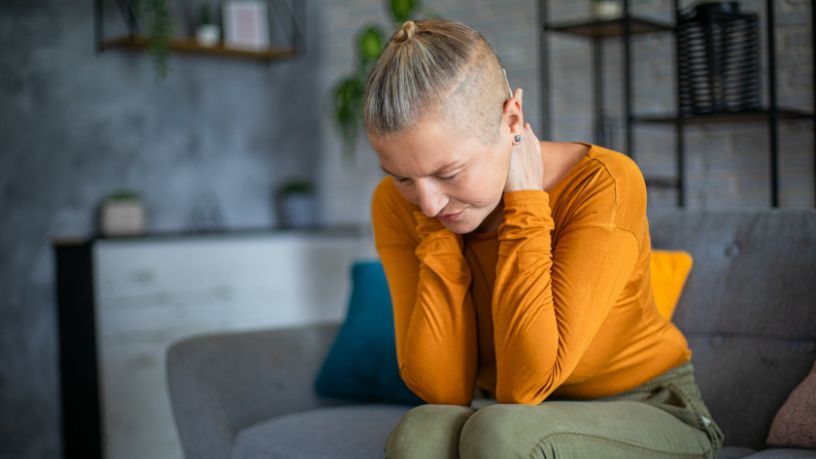Back pain impacts most of us at least once in our lifetimes.
On this page
Key takeaways
Most back pain is short term and can be easily treated with gentle exercise and mild medications.
Speak to your GP if your back pain is severe or long lasting to ensure you get correct and effective advice and treatment.
Back pain can range from minor niggles to crippling pain that seriously impacts quality of life and can lead to serious health issues.
We look at different kinds of back pain, how it might be caused and different ways to manage it.
Common causes of back pain
It can be difficult to know exactly what causes back pain. It’s often related to a sprain or strain in one of the interconnecting structures in the back related to lifting a heavy object or a fall or injury.
Specific conditions such as osteoporosis or arthritis can be a direct cause of back pain, as can a slipped disc in the back, an infection or even some types of cancer.
More common causes of back pain include:
- lack of exercise, or standing, sitting or bending down for long periods
- lifting, carrying, pushing or pulling heavy loads
- a trip or a fall
- being stressed or anxious (which can increase muscle tension as well as heighten pain perception)
- being overweight
- poor posture.
Types of back pain
You may experience low back pain as tension, soreness or stiffness in your lower back area. This pain is often referred to as 'non-specific' back pain and may improve on its own within a few days.
You may have:
- acute back pain (lasting less than 6 weeks)
- sub-acute back pain (lasting 6 weeks to 3 months)
- chronic back pain (lasting longer than 3 months).
Your doctor may recommend treatment options based on the type of back pain you have and your individual risk factors, such as weight, age and other health conditions or concerns.
When to see a doctor for back pain
See your GP as soon as possible if you experience back pain and any of the following:
- Loss of bladder or bowel control or difficulty urinating
- Numbness or tingling around your genitals or buttocks
- Numbness, pins and needles or weakness in one or both legs, your back or anywhere else
- Chest pain
- A fever
- Unexplained weight loss
- Redness or swelling on your back
- Pain that doesn’t improve after resting or gets worse, particularly at night
- Pain that starts after a fall or injury.
These symptoms are known as red flags, and they could be a sign of something more serious.
If it’s hard to get an appointment in person with your GP, online consultations can be a good place to start.
Book online doctors
Access online doctors for simple medical health needs like requesting a prescription, asking for a medical certificate, or medical advice that may not need a physical consultation. Available to eligible Bupa members.
In an emergency, call 000.
Treatment options for back pain
Self-help
There are many things you can do at home to help with low back pain, including the following:
- Stay active and continue your daily activities as normally as you can. Prolonged bed rest may make back pain worse.
- Include some regular walking. An Australian study found regular walking combined with pain education to be effective at reducing back pain and lowering the chances of it recurring.2
- Try some simple back exercises or stretches recommended by your GP or physiotherapist.
- Learn how to safely lift and carry items, and avoid heavy lifting and twisting.
- Apply heat or cold to the affected area. Some people find that this may help in the short term. You can buy specially designed heat or cold packs from most pharmacies.
Medication
For temporary use, an over-the-counter anti-inflammatory medicine (such as ibuprofen) can help ease pain.
You could also try creams, lotions and gels that contain anti-inflammatory ingredients. Don’t apply an anti-inflammatory cream as well as taking an anti-inflammatory medication, as they can interact. Talk to your GP or pharmacist for more advice about using anti-inflammatory medicines.
If your pain is severe or chronic, your GP may prescribe stronger medication.
Always read the accompanying consumer medicine information leaflet, and ask your GP or pharmacist for advice if you have any questions.
Physical therapy
Physical therapies may be recommended as part of a treatment program for back pain. This may involve things like exercises, posture advice or massage with a physiotherapist.
Surgery
Back pain can usually be managed with some of the simple treatments listed above, but a small percentage of people may have ongoing problems. Back surgery is usually a last resort.
Bupa Health Programs
Discover our programs designed to help you recover and stay out of hospital where you can.
How to prevent back pain
Good back care can help reduce your risk of getting low back pain. To help look after your back, make sure you:
- take regular exercise. Low-impact activities such as walking and swimming are often recommended
- try relaxation techniques to help keep your stress levels to a minimum
- learn how to lift and carry objects (or children) safely. Squat down, hold the object close to your body and lift with your legs, always keeping your back straight. Always get help or use equipment if a load is too heavy
- maintain good posture, keep your shoulders back and don't slouch.
Resources
Musculoskeletal Health Australia provides information and support for people living with arthritis and musculoskeletal conditions. Visit their website or call them on 1800 263 265.
Pain Australia works towards improving the quality of life for those living with pain. Visit their website for resources and support, including their National Pain Services Directory.
Chronic Pain Australia hosts an online forum to connect people living with chronic pain. There are also resources and information for people, their carers and their families.
Pain Management Network enables you to develop skills and knowledge in the self-management of your pain in partnership with your healthcare providers. It also includes a dedicated youth channel.
More Good Days provides evidence-based and low-risk digital programs to help people with persistent pain.
Tame the Beast provides education on retraining your pain system to reduce persistent pain.

At Bupa, trust is everything
Our health and wellbeing information is regularly reviewed and maintained by a team of healthcare experts, to ensure its relevancy and accuracy. Everyone's health journey is unique and health outcomes vary from person to person.
This content is not a replacement for personalised and specific medical, healthcare, or other professional advice. If you have concerns about your health, see your doctor or other health professional.
1Australian Institute of Health and Welfare. (2024). Chronic musculoskeletal conditions: Back problems. Australian Government, Australian Institute of Health and Welfare.
2Pocovi, N. C., Lin, C. C., French, S. D., Graham, P. L., van Dongen, J. M., Latimer, J., Merom, D., Tiedemann, A., Maher, C. G., Clavisi, O., Tong, S. Y. K., & Hancock, M. J. (2024). Effectiveness and cost-effectiveness of an individualised, progressive walking and education intervention for the prevention of low back pain recurrence in Australia (WalkBack): a randomised controlled trial. The Lancet, 24, 00755-4.
You might also like...
Back surgery: Types, procedures and recovery
Find out about the different types of back surgery used to treat back pain, how they work and what you need to do to prepare and recover.
5 key stretches to help relieve lower back pain
Sore lower back? These 5 simple physio-approved stretches can help ease pain and release tension at home.
Taking control of chronic pain
Living with chronic pain can impact every aspect of your life. Here’s what you can do to take back the control.
Chronic pain and sleep: How to break the cycle
For those living with chronic pain, poor sleep usually comes with the territory. But it doesn’t have to. Learn how to break the cycle.





